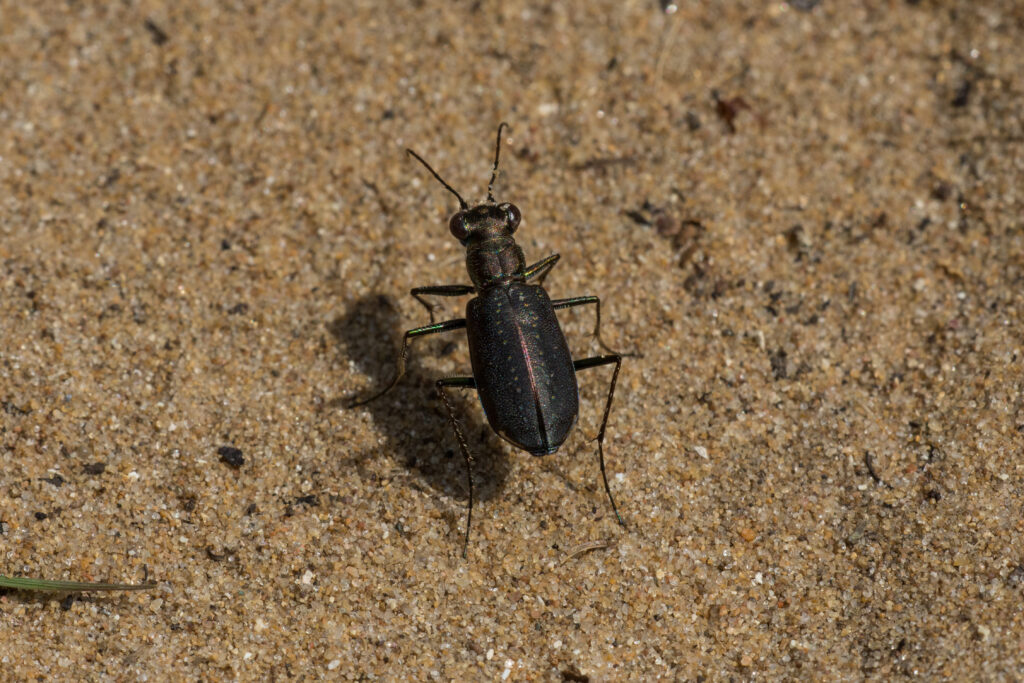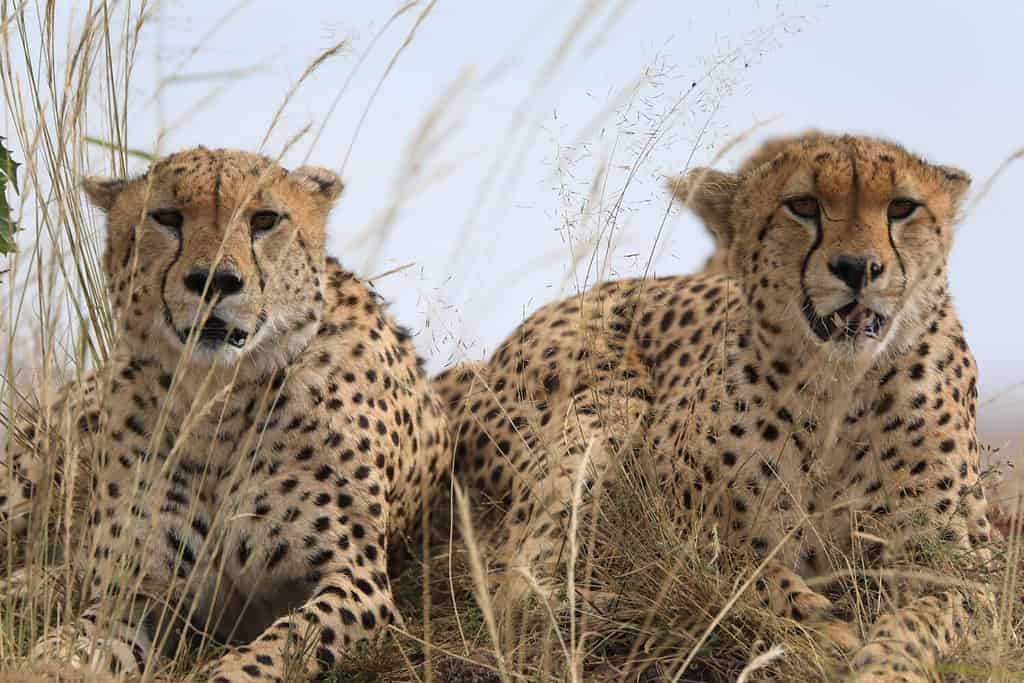The Australian tiger beetle (Cicindela hudsoni) is the world’s fastest running insect! They run the equivalent of 5.6 miles per hour. Even in absolute terms, that is fast for humans. A walk is 2.5 mph. And 5.6 on a treadmill is a “decent clip” for sure.
It’s the swiftest ground-borne insect on Earth. Literally, on Earth, it cannot fly. Entomologists believe it adapted quite thoroughly to its sandy, sparse environment of salty Australian lakes. So much so that it only has “vestigial” wings.
Call Guinness, We Think It’s Official

This is actually the punctured
tiger
beetle, a US cousin of the Australian tiger beetle but—except for functional wings—they share similar body types: six long, spindly legs; colossal eyes, and an antennae with a curly tip.
©Paul Sparks/Shutterstock.com
The Guinness Book of World Records has certified that Cicindela hudsoni, the Australian tiger beetle, is the fastest insect on land. It beat out the American cockroach, which had the record at 3.4 mph.
The cheetah is still the fastest animal in absolute terms. And it’s not just fast; it can literally go zero to 60 in three seconds like a supercar. But for size, the Australian tiger beetle is the champ.
This track star cruises at 120 to 171 body lengths per second.
The World’s Fastest Running Insect, Looking Closer
Its body length is just over 3/4 inches long (2 cm). At the top end of 171 body lengths per second, 342 cm is just over 11 feet; a sprint indeed for just one second.
As we might think, Australian tiger beetles are very beetle-like in appearance. They have a shiny flourishing body that stands out on their shell. Their eyes are enormous, and they have noticeable protruding horn-like antennae.
New species of animal are discovered every year. Beetles alone have thousands of species, so defining a type is tricky. These Australian tiger beetles were even trickier in that they weren’t found that long ago, as far as bugs are concerned. They thrived in and near extremely salty lakes in the more isolated spots of Australia, with virtually no human presence for most of Earth’s history.
What we know about tiger beetles or even who is a tiger beetle may change.
Australian Tiger Beetles Use Their Speed to Hunt
These beetles are well-equipped as predators, and their speed has much to do with that. With little substantial ground vegetation in their sandy, dry environment, there has been little to get in their way. They’ve learned to sprint with surprising force and nab prey quickly.
Another built-in feature for this running insect is their tusk-like pair of mandibles that scoop up and smash prey.
Beetles, Fixing a Hole
Even baby beetles, apparently before they get their sand legs, can hunt. They will burrow down and leave only their heads above ground. They’ll then snatch passing insects. This species of running insect has indeed adapted and appears to show some level of intelligence.
Their go-to meal is spiders and other members of their arthropod group.
Lastly, of course, are their large, beetley, bulbous eyes. These give them a big assist in their hunt for prey. But not always. Sometimes, their eyes have to buffer. Let’s explain.
How, On Earth, Can It Move So Fast?

In absolute terms, cheetahs are the fastest land animal, but millimeter-for-millimeter against their body length, Australian tiger beetles leave cheetahs in the dust!
©Travelnshot/Shutterstock.com
Because their ticky-tack sprints are so ridiculously fast, Australian tiger beetles temporarily go blind. The world’s fastest running insect might need a better data plan with better buffering speeds. Their vision disappears momentarily because light photons cannot enter and process their eyes at such a breakneck speed. Those huge eyes also help them calibrate their moves to the horizon.
The extreme climate in the salty, sparse southern Outback works to their advantage in other ways. “Inhabiting a patch of habitat near Lake Gairdner in South Australia, these beetles use the hot, arid climate to their advantage. Being exothermic, the high temperatures boost their metabolism and speed, while their long legs protect them from the worst of the ground heat,” Skai Peterson, a doctoral student of entomology at Texas A&M, tells us in an email.
These beetles also have a handy digestive appliance built-in; according to Peterson, “. . . their digestive systems can only handle fluids. Thus, they rely on pharyngeal hairs called setae to filter out solids while they feed.”
Speed Comparisons of the World’s Fastest Running Insect
Forming a precise millimeter-to-millimeter comparison is tricky when gauging speed. For its weight class, as it were, the Australian tiger beetle is the fastest insect on land. There are actually many ultra-fast insects, including one that goes the equivalent of 90 miles per hour in flight!
In the air is another story. Those bugs can haul. But even against, say, a human, this rugged beetle is fast. Various sources note that a human moving well over 100 body lengths per second would mean they’d nearly break the sound barrier.
Fast and the Furious
They move fast. Australian tiger beetles are the supercars of the beetle world, and they can also handle the gnarliest climates on Earth. A fascinating organism indeed.
The photo featured at the top of this post is © iStock.com/ViniSouza128
Thank you for reading! Have some feedback for us? Contact the AZ Animals editorial team.







